How To Point Camera Straight Down

Staircase in ii-point perspective
| External video | |
|---|---|
 | |
| | |
| | |
| |
Linear or point-projection perspective (from Latin: perspicere 'to see through') is one of two types of graphical project perspective in the graphic arts; the other is parallel project. Linear perspective is an judge representation, more often than not on a flat surface, of an image as information technology is seen by the eye. The most characteristic features of linear perspective are that objects announced smaller every bit their distance from the observer increases, and that they are bailiwick to foreshortening, pregnant that an object'southward dimensions along the line of sight appear shorter than its dimensions across the line of sight. All objects volition recede to points in the altitude, unremarkably forth the horizon line, but too above and below the horizon line depending on the view used.
Italian Renaissance painters and architects including Masaccio, Paolo Uccello, Piero della Francesca and Luca Pacioli studied linear perspective, wrote treatises on information technology, and incorporated it into their artworks.
Overview [edit]

A cube in two-point perspective

Rays of light travel from the object, through the motion picture airplane, and to the viewer'south eye. This is the footing for graphical perspective.
Perspective works by representing the light that passes from a scene through an imaginary rectangle (realized equally the plane of the painting), to the viewer'due south eye, every bit if a viewer were looking through a window and painting what is seen directly onto the windowpane. If viewed from the same spot as the windowpane was painted, the painted epitome would be identical to what was seen through the unpainted window. Each painted object in the scene is thus a flat, scaled downwards version of the object on the other side of the window.[4] Because each portion of the painted object lies on the directly line from the viewer's eye to the equivalent portion of the real object it represents, the viewer sees no departure (sans depth perception) between the painted scene on the windowpane and the view of the existent scene. All perspective drawings presume the viewer is a certain altitude abroad from the drawing. Objects are scaled relative to that viewer. An object is often not scaled evenly: a circle tin can be flattened to an eccentric ellipse and a square can appear as a trapezoid or any other convex quadrilateral. This distortion is referred to every bit foreshortening.
Perspective drawings have a horizon line, which is ofttimes implied. This line, directly opposite the viewer'southward eye, represents objects infinitely far away. They have shrunk, in the altitude, to the infinitesimal thickness of a line. Information technology is analogous to (and named after) the World'south horizon.
Any perspective representation of a scene that includes parallel lines has ane or more vanishing points in a perspective cartoon. A one-point perspective cartoon means that the drawing has a single vanishing point, commonly (though not necessarily) directly reverse the viewer'southward eye and usually (though not necessarily) on the horizon line. All lines parallel with the viewer'south line of sight recede to the horizon towards this vanishing bespeak. This is the standard "receding railroad tracks" phenomenon. A two-point drawing would have lines parallel to ii dissimilar angles. Any number of vanishing points are possible in a cartoon, one for each set of parallel lines that are at an angle relative to the plane of the drawing.
Perspectives consisting of many parallel lines are observed nearly frequently when drawing architecture (compages frequently uses lines parallel to the x, y, and z axes). Because it is rare to have a scene consisting solely of lines parallel to the three Cartesian axes (x, y, and z), it is rare to see perspectives in practice with only 1, two, or three vanishing points; even a simple house frequently has a peaked roof which results in a minimum of six sets of parallel lines, in turn corresponding to up to vi vanishing points.
Of the many types of perspective drawings, the nigh common categorizations of artificial perspective are one-, two- and iii-point. The names of these categories refer to the number of vanishing points in the perspective cartoon.

In this photograph, atmospheric perspective is demonstrated by variously afar mountains
Aerial perspective [edit]
Aerial (or atmospheric) perspective depends on afar objects beingness more obscured by atmospheric factors, so farther objects are less visible to the viewer. As the distance between an object and a viewer increases, the contrast betwixt the object and its background decreases, and the contrast of any markings or details within the object also decreases. The colours of the object too become less saturated and shift towards the background color.
Aerial perspective tin can be combined with, but does not depend on, ane or more vanishing points.
One-bespeak perspective [edit]
A drawing has one-point perspective when it contains simply one vanishing point on the horizon line. This type of perspective is typically used for images of roads, railway tracks, hallways, or buildings viewed then that the front is directly facing the viewer. Any objects that are made upward of lines either directly parallel with the viewer's line of sight or direct perpendicular (the railroad ties/sleepers) tin can be represented with one-bespeak perspective. These parallel lines converge at the vanishing point.
One-point perspective exists when the picture plane is parallel to two axes of a rectilinear (or Cartesian) scene—a scene which is composed entirely of linear elements that intersect only at right angles. If 1 axis is parallel with the movie plane, and so all elements are either parallel to the picture plane (either horizontally or vertically) or perpendicular to it. All elements that are parallel to the movie airplane are fatigued as parallel lines. All elements that are perpendicular to the film aeroplane converge at a single bespeak (a vanishing betoken) on the horizon.
- Examples of one-point perspective
-

-
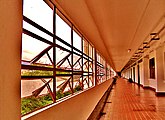
-
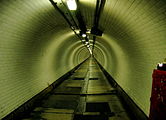
-

-

-

-

-
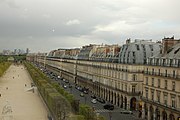

A cube drawing using ii-signal perspective
Two-point perspective [edit]
A drawing has two-point perspective when it contains 2 vanishing points on the horizon line. In an illustration, these vanishing points can be placed arbitrarily along the horizon. Two-signal perspective can be used to draw the same objects every bit one-point perspective, rotated: looking at the corner of a house, or at two forked roads shrinking into the distance, for example. One point represents one fix of parallel lines, the other indicate represents the other. Seen from the corner, one wall of a house would recede towards one vanishing indicate while the other wall recedes towards the opposite vanishing betoken.
Two-betoken perspective exists when the moving picture plane is parallel to a Cartesian scene in one axis (usually the z-axis) simply non to the other ii axes. If the scene beingness viewed consists solely of a cylinder sitting on a horizontal plane, no departure exists in the image of the cylinder betwixt a one-betoken and two-point perspective.
2-point perspective has one set of lines parallel to the picture plane and 2 sets oblique to information technology. Parallel lines oblique to the picture plane converge to a vanishing signal, which means that this set-upward will require two vanishing points.
- Examples of two-point perspective
-

-

-

-
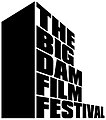
-


A cube in three-point perspective
Three-indicate perspective [edit]
3-point perspective is often used for buildings seen from above (or below). In addition to the two vanishing points from before, one for each wall, there is now one for how the vertical lines of the walls recede. For an object seen from to a higher place, this third vanishing point is below the ground. For an object seen from below, as when the viewer looks up at a alpine edifice, the third vanishing betoken is high in space.
Three-point perspective exists when the perspective is a view of a Cartesian scene where the pic plane is not parallel to any of the scene'southward three axes. Each of the iii vanishing points corresponds with 1 of the three axes of the scene. 1, two and iii-point perspectives appear to embody different forms of calculated perspective, and are generated by dissimilar methods. Mathematically, all the same, all three are identical; the difference is merely in the relative orientation of the rectilinear scene to the viewer.
- Examples of 3-point perspective
-

-
-

Curvilinear perspective [edit]
By superimposing two perpendicular, curved sets of two-point perspective lines, a four-or-higher up-indicate curvilinear perspective tin be achieved. This perspective can be used with a central horizon line of whatsoever orientation, and can depict both a worm'southward-eye and bird's-eye view at the same time.
Additionally, a fundamental vanishing point can exist used (just equally with i-betoken perspective) to indicate frontal (foreshortened) depth.[5]
- Examples of curvilinear perspective
-

-

Foreshortening [edit]

Two different projections of a stack of two cubes, illustrating oblique parallel projection foreshortening ("A") and perspective foreshortening ("B")
Foreshortening is the visual effect or optical illusion that causes an object or distance to appear shorter than it really is because it is angled toward the viewer. Additionally, an object is oftentimes not scaled evenly: a circumvolve frequently appears every bit an ellipse and a square can announced every bit a trapezoid.
Although foreshortening is an of import element in fine art where visual perspective is being depicted, foreshortening occurs in other types of two-dimensional representations of iii-dimensional scenes. Some other types where foreshortening can occur include oblique parallel projection drawings. Foreshortening also occurs when imaging rugged terrain using a constructed-aperture radar arrangement.[ citation needed ]
In painting, foreshortening in the depiction of the human being figure was improved during the Italian Renaissance, and the Lamentation over the Dead Christ by Andrea Mantegna (1480s) is 1 of the near famous of a number of works that show off the new technique, which thereafter became a standard part of the training of artists. (Andrea Mantegna is also an author of the Frescoes in the Photographic camera degli Sposi; in which a part chosen "The oculus" uses foreshortening represented by the figures which await downward upon the watchers.)
History [edit]

Rudimentary attempts to create the illusion of depth were made in aboriginal times, with artists achieving isometric projection by the Middle Ages. Various early Renaissance works describe perspective lines with an implied convergence, albeit without a unifying vanishing indicate. It is commonly accepted that the commencement to principal perspective was Italian Renaissance architect Filippo Brunelleschi, who adult the adherence of perspective to a vanishing point in the early fifteenth century. It is said that his discovery was immediately influential on subsequent Renaissance fine art and was explored contemporaneously in manuscripts by Leon Battista Alberti, Piero della Francesca and others.
This scenario is yet debated, yet, considering Brunelleschi'south tavoletta is lost, which does non allow a direct assessment of the correctness of his perspective construction, and considering the weather condition listed past Antonio di Tuccio Manetti in his Vita di Ser Brunellesco are inconsistent.[7]
Early history [edit]


The floor tiles in Lorenzetti's Annunciation (1344) strongly anticipate modernistic perspective.
The earliest art paintings and drawings typically sized many objects and characters hierarchically according to their spiritual or thematic importance, not their distance from the viewer, and did not use foreshortening. The nigh of import figures are oftentimes shown every bit the highest in a composition, also from hieratic motives, leading to the so-called "vertical perspective", common in the fine art of Ancient Egypt, where a group of "nearer" figures are shown beneath the larger figure or figures; simple overlapping was as well employed to relate distance.[eight] Additionally, oblique foreshortening of round elements like shields and wheels is evident in Ancient Greek red-effigy pottery.[9]
Systematic attempts to evolve a system of perspective are normally considered to have begun around the fifth century BC in the art of ancient Greece, as role of a developing interest in illusionism centrolineal to theatrical scenery. This was detailed within Aristotle's Poetics every bit skenographia: using flat panels on a stage to give the illusion of depth.[10] The philosophers Anaxagoras and Democritus worked out geometric theories of perspective for use with skenographia. Alcibiades had paintings in his house designed using skenographia, and then this art was not confined merely to the stage. Euclid in his Optics (c. 300 BC) argues correctly that the perceived size of an object is non related to its distance from the eye by a simple proportion.[eleven] In the outset-century BC frescoes of the Villa of P. Fannius Synistor, multiple vanishing points are used in a systematic but not fully consistent manner.[6]
Chinese artists fabricated utilize of oblique projection from the starting time or second century until the 18th century. Information technology is not certain how they came to use the technique; Dubery and Willats (1983) speculate that the Chinese acquired the technique from India, which caused it from Ancient Rome,[12] while others credit it equally an indigenous invention of Ancient Prc.[13] [xiv] [15] Oblique projection is as well seen in Japanese art, such every bit in the Ukiyo-eastward paintings of Torii Kiyonaga (1752–1815).[12] [a]
Various paintings and drawings from the Middle Ages show amateur attempts at projections of objects, where parallel lines are successfully represented in isometric projection, or by nonparallel ones without a vanishing point.
By the later periods of antiquity, artists, especially those in less popular traditions, were well enlightened that distant objects could exist shown smaller than those shut at hand for increased realism, but whether this convention was actually used in a piece of work depended on many factors. Some of the paintings found in the ruins of Pompeii show a remarkable realism and perspective for their time.[16] It has been claimed that comprehensive systems of perspective were evolved in antiquity, simply well-nigh scholars do not accept this. Hardly any of the many works where such a system would take been used have survived. A passage in Philostratus suggests that classical artists and theorists thought in terms of "circles" at equal distance from the viewer, similar a classical semi-circular theatre seen from the phase.[17] The roof beams in rooms in the Vatican Virgil, from about 400 AD, are shown converging, more than or less, on a common vanishing indicate, but this is not systematically related to the residual of the composition.[eighteen] In the Late Antique menstruum use of perspective techniques declined. The fine art of the new cultures of the Migration Period had no tradition of attempting compositions of big numbers of figures and Early on Medieval art was irksome and inconsistent in relearning the convention from classical models, though the procedure can be seen underway in Carolingian fine art.
Medieval artists in Europe, like those in the Islamic world and China, were enlightened of the general principle of varying the relative size of elements co-ordinate to distance, but even more than classical fine art were perfectly ready to override it for other reasons. Buildings were often shown obliquely according to a particular convention. The utilise and sophistication of attempts to convey altitude increased steadily during the menses, but without a basis in a systematic theory. Byzantine art was too aware of these principles, just too used the reverse perspective convention for the setting of principal figures. Ambrogio Lorenzetti painted a floor with convergent lines in his Presentation at the Temple (1342), though the balance of the painting lacks perspective elements.[nineteen] Other artists of the greater proto-Renaissance, such as Melchior Broederlam, strongly predictable mod perspective in their works but lacked the constraint of a vanishing signal.
Renaissance [edit]

Masolino da Panicale's St. Peter Healing a Cripple and the Raising of Tabitha (c. 1423), the primeval extant artwork known to utilize a consistent vanishing indicate[xx] (detail)
Information technology is mostly accepted that Filippo Brunelleschi conducted a serial of experiments betwixt 1415 and 1420, which included making drawings of various Florentine buildings in correct perspective.[21] According to Vasari and Antonio Manetti, in nigh 1420, Brunelleschi demonstrated his discovery by having people await through a pigsty in the dorsum of a painting he had made. Through it, they would run across a building such equally the Florence Baptistery. When Brunelleschi lifted a mirror in front of the viewer, it reflected his painting of the buildings which had been seen previously, then that the vanishing indicate was centered from the perspective of the participant.[22] Brunelleschi practical the new system of perspective to his paintings around 1425.[23]
This scenario is indicative, but faces several problems. Start of all, cipher can be said for certain well-nigh the perspective of the baptistery of San Giovanni, considering Brunelleschi's console is lost. 2nd, no other perspective painting past Brunelleschi is known. Third, in the business relationship written by Antonio di Tuccio Manetti at the end of the 15th century on Brunelleschi'due south panel, there is not a unmarried occurrence of the word experiment. Fourth, the conditions listed by Antonio di Tuccio Manetti are contradictory with each other. For example, the description of the eyepiece sets a visual field of fifteen° much narrower than the visual field resulting from the urban landscape described.[24]

Before long afterward Brunelleschi's demonstrations, nearly every artist in Florence and in Italy used geometrical perspective in their paintings and sculpture,[25] notably Donatello, Masaccio, Lorenzo Ghiberti, Masolino da Panicale, Paolo Uccello, and Filippo Lippi. Not only was perspective a fashion of showing depth, information technology was as well a new method of creating a composition. Visual fine art could now describe a single, unified scene, rather than a combination of several. Early examples include Masolino's St. Peter Healing a Cripple and the Raising of Tabitha (c. 1423), Donatello's The Feast of Herod (c. 1427), too as Ghiberti's Jacob and Esau and other panels from the e doors of the Florence Baptistery.[26] Masaccio (d. 1428) achieved an illusionistic effect by placing the vanishing point at the viewer'southward eye level in his Holy Trinity (c. 1427),[27] and in The Tribute Money, it is placed backside the face of Jesus.[28] [b] In the late 15th century, Melozzo da Forlì starting time practical the technique of foreshortening (in Rome, Loreto, Forlì and others).[thirty]
This overall story is based on qualitative judgments, and would need to be faced against the material evaluations that have been conducted on Renaissance perspective paintings. Apart from the paintings of Piero della Francesca, which are a model of the genre, the majority of 15th century works show serious errors in their geometric construction. This is true of Masaccio's Trinity fresco[31] and of many works, including those by renowned artists like Leonardo da Vinci.[32]
As shown by the quick proliferation of accurate perspective paintings in Florence, Brunelleschi likely understood (with assistance from his friend the mathematician Toscanelli),[33] but did not publish, the mathematics behind perspective. Decades later, his friend Leon Battista Alberti wrote De pictura (c. 1435), a treatise on proper methods of showing distance in painting. Alberti's chief quantum was not to show the mathematics in terms of conical projections, as it actually appears to the eye. Instead, he formulated the theory based on planar projections, or how the rays of light, passing from the viewer's eye to the mural, would strike the picture show airplane (the painting). He was then able to calculate the apparent height of a distant object using two similar triangles. The mathematics behind similar triangles is relatively unproblematic, having been long agone formulated by Euclid.[c] Alberti was also trained in the science of optics through the school of Padua and under the influence of Biagio Pelacani da Parma who studied Alhazen'due south Book of Optics.[34] This book, translated effectually 1200 into Latin, had laid the mathematical foundation for perspective in Europe.[35]
Perspective remained, for a while, the domain of Florence. Jan van Eyck, among others, failed to utilize a consistent vanishing bespeak for the converging lines in paintings, as in the Arnolfini Portrait (1434). Gradually, and partly through the movement of academies of the arts, the Italian techniques became part of the training of artists beyond Europe, and later other parts of the world.

Piero della Francesca elaborated on De pictura in his De Prospectiva pingendi in the 1470s, making many references to Euclid.[36] Alberti had limited himself to figures on the ground plane and giving an overall ground for perspective. Della Francesca fleshed information technology out, explicitly roofing solids in any surface area of the picture airplane. Della Francesca as well started the at present common practice of using illustrated figures to explain the mathematical concepts, making his treatise easier to understand than Alberti's. Della Francesca was also the first to accurately draw the Platonic solids equally they would appear in perspective. Luca Pacioli'south 1509 Divina proportione (Divine Proportion), illustrated by Leonardo da Vinci, summarizes the apply of perspective in painting, including much of Della Francesca'southward treatise.[37] Leonardo practical one-point perspective also as shallow focus to some of his works.[38]
Two-betoken perspective was demonstrated every bit early on as 1525 by Albrecht Dürer, who studied perspective by reading Piero and Pacioli's works, in his Unterweisung der messung ("Instruction of the measurement").[39]
Perspective features heavily in the research of the 17th-century architect, geometer, and optician Girard Desargues on perspective, optics and projective geometry, as well equally the theorem named after him.
Limitations [edit]

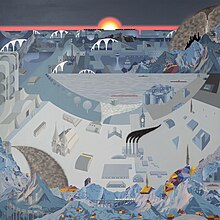
Instance of a painting that combines diverse perspectives: The Frozen Urban center (Museum of Art Aarau, Switzerland) by Matthias A. Grand. Zimmermann
Perspective images are calculated assuming a particular vanishing indicate. In gild for the resulting prototype to appear identical to the original scene, a viewer of the perspective must view the image from the exact vantage point used in the calculations relative to the image. This cancels out what would appear to be distortions in the epitome when viewed from a different point. These apparent distortions are more pronounced away from the eye of the epitome equally the angle between a projected ray (from the scene to the eye) becomes more than astute relative to the picture plane. In practice, unless the viewer chooses an farthermost angle, like looking at it from the lesser corner of the window, the perspective normally looks more than or less right. This is referred to every bit "Zeeman's Paradox".[40] It has been suggested that a drawing in perspective nevertheless seems to be in perspective at other spots because we still perceive it as a drawing, because it lacks depth of field cues.[41]
For a typical perspective, notwithstanding, the field of view is narrow enough (often just 60 degrees) that the distortions are similarly minimal enough that the epitome tin can be viewed from a point other than the actual calculated vantage point without actualization significantly distorted. When a larger angle of view is required, the standard method of projecting rays onto a flat picture plane becomes impractical. As a theoretical maximum, the field of view of a flat film airplane must be less than 180 degrees (as the field of view increases towards 180 degrees, the required breadth of the movie plane approaches infinity).
To create a projected ray epitome with a big field of view, one tin project the image onto a curved surface. To have a large field of view horizontally in the image, a surface that is a vertical cylinder (i.e., the axis of the cylinder is parallel to the z-centrality) will suffice (similarly, if the desired large field of view is only in the vertical direction of the epitome, a horizontal cylinder will suffice). A cylindrical moving-picture show surface volition permit for a projected ray image up to a full 360 degrees in either the horizontal or vertical dimension of the perspective image (depending on the orientation of the cylinder). In the same way, by using a spherical picture surface, the field of view can be a full 360 degrees in any direction. For a spherical surface, all projected rays from the scene to the center intersect the surface at a right angle.
Simply every bit a standard perspective image must be viewed from the calculated vantage point for the epitome to announced identical to the truthful scene, a projected epitome onto a cylinder or sphere must likewise be viewed from the calculated vantage betoken for information technology to be precisely identical to the original scene. If an paradigm projected onto a cylindrical surface is "unrolled" into a apartment paradigm, dissimilar types of distortions occur. For case, many of the scene's straight lines will be drawn as curves. An prototype projected onto a spherical surface can be flattened in various means:
- An image equivalent to an unrolled cylinder
- A portion of the sphere tin can be flattened into an image equivalent to a standard perspective
- An image similar to a fisheye photograph
See also [edit]
- Anamorphosis
- Camera angle
- Cutaway drawing
- Perspective control
- Trompe-50'œil
- Uki-eastward
- Zograscope
Notes [edit]
- ^ In the 18th century, Chinese artists began to combine oblique perspective with regular diminution of size of people and objects with distance; no particular vantage point is called, but a convincing effect is accomplished.[12]
- ^ Most the finish of the 15th century, Leonardo da Vinci placed the vanishing betoken in his Last Supper backside Christ's other cheek.[29]
- ^ In viewing a wall, for instance, the first triangle has a vertex at the user's centre, and vertices at the top and bottom of the wall. The bottom of this triangle is the altitude from the viewer to the wall. The second, similar triangle, has a point at the viewer's heart, and has a length equal to the viewer'southward centre from the painting. The superlative of the second triangle can then be adamant through a simple ratio, equally proven by Euclid.
References [edit]
- ^ "Linear Perspective: Brunelleschi's Experiment". Smarthistory at Khan University. Archived from the original on 24 May 2013. Retrieved 12 May 2013.
- ^ "How One-Betoken Linear Perspective Works". Smarthistory at Khan University. Archived from the original on 13 July 2013. Retrieved 12 May 2013.
- ^ "Empire of the Centre: The Magic of Illusion: The Trinity-Masaccio, Function 2". National Gallery of Art at ArtBabble. Archived from the original on i May 2013. Retrieved 12 May 2013.
- ^ D'Amelio, Joseph (2003). Perspective Drawing Handbook . Dover. p. 19. ISBN9780486432083.
- ^ "The Beginner'south Guide to Perspective Drawing". The Curiously Artistic . Retrieved 17 August 2019.
- ^ a b Hurt, Carla (nine August 2013). "Romans paint amend perspective than Renaissance artists". Plant in Antiquity . Retrieved 4 October 2020.
- ^ Raynaud, Dominique (2014). Optics and the Rise of Perspective. Oxford: Bardwell Press. pp. one–two].
- ^ Calvert, Amy. "Egyptian Art (commodity) | Ancient Arab republic of egypt". Khan Academy . Retrieved fourteen May 2020.
- ^ Regoli, Gigetta Dalli; Gioseffi, Decio; Mellini, Gian Lorenzo; Salvini, Roberto (1968). Vatican Museums: Rome . Italy: Newsweek. p. 22.
- ^ "Skenographia in Fifth Century". CUNY. Archived from the original on 17 December 2007. Retrieved 27 December 2007.
- ^ Smith, A. Mark (1999). Ptolemy and the Foundations of Ancient Mathematical Optics: A Source Based Guided Study. Philadelphia: American Philosophical Gild. p. 57. ISBN978-0-87169-893-iii.
- ^ a b c Cucker, Felipe (2013). Manifold Mirrors: The Crossing Paths of the Arts and Mathematics. Cambridge University Press. pp. 269–278. ISBN978-0-521-72876-8.
Dubery and Willats (1983:33) write that 'Oblique projection seems to have arrived in China from Rome by style of India round near the first or second century AD.'
Figure 10.9 [Wen-Chi returns domicile, betimes, China, 12th century] shows an classic of the classical use of oblique perspective in Chinese painting. - ^ "Seeing History: Is perspective learned or natural?". Eclectic Light. 10 January 2018.
Over the aforementioned period, the development of sophisticated and highly-detailed visual art in Asia arrived at a slightly different solution, now known equally the oblique project. Whereas Roman and subsequent European visual art effectively had multiple and incoherent vanishing points, Asian fine art usually lacked whatsoever vanishing indicate, but aligned recession in parallel. An important cistron here is the employ of long scrolls, which even now make fully coherent perspective projection unsuitable.
- ^ Martijn de Geus (nine March 2019). "Communist china Projections". Arch Daily . Retrieved eight July 2020.
- ^ Krikke, January (2 January 2018). "Why the world relies on a Chinese "perspective"". Medium.com.
About 2000 years agone, the Chinese developed dengjiao toushi (等角透視), a graphic tool probably invented by Chinese architects. It came to be known in the West as axonometry. Axonometry was crucial in the evolution of the Chinese manus scroll painting, an art grade that art historian George Rowley referred to as "the supreme creation of Chinese genius". Classic hand gyre paintings were upwardly to ten meters in length. They are viewed past unrolling them from correct to left in equal segments of about l cm. The painting takes the viewer through a visual story in space and time.
- ^ "Pompeii. House of the Vettii. Fauces and Priapus". SUNY Buffalo. Archived from the original on 24 December 2007. Retrieved 27 December 2007.
- ^ Panofsky, Erwin (1960). Renaissance and Renascences in Western Art . Stockholm: Almqvist & Wiksell. p. 122, annotation ane. ISBN0-06-430026-9.
- ^ Vatican Virgil image
- ^ Heidi J. Hornik and Mikeal Carl Parsons, Illuminating Luke: The infancy narrative in Italian Renaissance painting, p. 132
- ^ "Perspective: The Ascent of Renaissance Perspective". WebExhibits . Retrieved 15 Oct 2020.
- ^ Gärtner, Peter (1998). Brunelleschi (in French). Cologne: Konemann. p. 23. ISBN3-8290-0701-9.
- ^ Edgerton 2009, pp. 44–46.
- ^ Edgerton 2009, p. forty.
- ^ Dominique Raynaud (1998). L'Hypothèse d'Oxford. Essai sur les origines de la perspective. Paris: Presses universitaires de French republic. pp. 132–141.
- ^ "...and these works (of perspective by Brunelleschi) were the means of arousing the minds of the other craftsmen, who afterwards devoted themselves to this with neat zeal."
Vasari's Lives of the Artists Chapter on Brunelleschi - ^ "The Gates of Paradise: Lorenzo Ghiberti's Renaissance Masterpiece". Art Institute of Chicago. 2007. Retrieved 20 September 2020.
- ^ Vasari, The Lives of the Artists, "Masaccio".
- ^ Adams, Laurie (2001). Italian Renaissance Art. Oxford: Westview Press. p. 98. ISBN978-0813349022.
- ^ White, Susan D. (2006). Draw Like Da Vinci. London: Cassell Illustrated, p. 132. ISBN 9781844034444.
- ^ Harness, Brenda. "Melozzo da Forli | Master of Foreshortening". Fine Art Affect . Retrieved 15 Oct 2020.
- ^ Judith V. Field; Roberto Lunardi; Thomas Settle (1989). "The perspective scheme of Masaccio's Trinity fresco". Nuncius. iv (2): 31–118. doi:x.1163/182539189X00680. Dominique Raynaud (1998). 50'Hypothèse d'Oxford. Paris: Presses universitaires de France. pp. 72–120.
- ^ Dominique Raynaud (2016). Studies on Binocular Vision. Cham: Springer International. pp. 53–67. ; Dominique Raynaud (2021). "Las fuentes ópticas de Leonardo". Leonardo da Vinci. Perspectiva y visión, ed. Luis Ramón-Laca. Alcalá de Henares: UAH. pp. 61–62.
- ^ "Messer Paolo dal Pozzo Toscanelli, having returned from his studies, invited Filippo with other friends to supper in a garden, and the discourse falling on mathematical subjects, Filippo formed a friendship with him and learned geometry from him."
Vasarai's Lives of the Artists, Chapter on Brunelleschi - ^ El-Bizri, Nader (2010). "Classical Optics and the Perspectiva Traditions Leading to the Renaissance". In Hendrix, John Shannon; Carman, Charles H. (eds.). Renaissance Theories of Vision (Visual Culture in Early Modernity) . Farnham, Surrey: Ashgate. pp. xi–30. ISBN978-ane-409400-24-0.
- ^ Hans, Belting (2011). Florence and Baghdad: Renaissance art and Arab science (1st English ed.). Cambridge, Massachusetts: Belknap Press of Harvard University Press. pp. xc–92. ISBN9780674050044. OCLC 701493612.
- ^ Livio, Mario (2003). The Aureate Ratio. New York: Broadway Books. p. 126. ISBN0-7679-0816-iii.
- ^ O'Connor, J. J.; Robertson, Due east. F. (July 1999). "Luca Pacioli". University of St Andrews. Archived from the original on 22 September 2015. Retrieved 23 September 2015.
- ^ Goldstein, Andrew Yard. (17 November 2011). "The Male "Mona Lisa"?: Fine art Historian Martin Kemp on Leonardo da Vinci's Mysterious "Salvator Mundi"". Blouin Artinfo.
- ^ MacKinnon, Nick (1993). "The Portrait of Fra Luca Pacioli". The Mathematical Gazette. 77 (479): 206. doi:10.2307/3619717. JSTOR 3619717.
- ^ Mathographics by Robert Dixon New York: Dover, p. 82, 1991.
- ^ "...the paradox is purely conceptual: it assumes we view a perspective representation as a retinal simulation, when in fact nosotros view it every bit a two dimensional painting. In other words, perspective constructions create visual symbols, not visual illusions. The key is that paintings lack the depth of field cues created past binocular vision; nosotros are always aware a painting is flat rather than deep. And that is how our mind interprets it, adjusting our understanding of the painting to recoup for our position."
"Handprint : Perspective in the world". Archived from the original on half dozen January 2007. Retrieved 25 Dec 2006. Retrieved on 25 December 2006
Sources [edit]
- Edgerton, Samuel Y. (2009). The Mirror, the Window & the Telescope: How Renaissance Linear Perspective Changed Our Vision of the Universe. Ithaca, NY: Cornell University Press. ISBN978-0-8014-4758-7.
Further reading [edit]
- Andersen, Kirsti (2007). The Geometry of an Art: The History of the Mathematical Theory of Perspective from Alberti to Monge. Springer.
- Damisch, Hubert (1994). The Origin of Perspective, Translated past John Goodman. Cambridge, Massachusetts: MIT Printing.
- Gill, Robert W (1974). Perspective From Basic to Artistic. Australia: Thames & Hudson.
- Hyman, Isabelle, comp (1974). Brunelleschi in Perspective. Englewood Cliffs, New Jersey: Prentice-Hall.
- Kemp, Martin (1992). The Scientific discipline of Fine art: Optical Themes in Western Fine art from Brunelleschi to Seurat. Yale University Press.
- Pérez-Gómez, Alberto, and Pelletier, Louise (1997). Architectural Representation and the Perspective Swivel. Cambridge, Massachusetts: MIT Press.
- Raynaud, Dominique (2014). Eyes and the Rise of Perspective. A Written report in Network Noesis Diffusion. Oxford: Bardwell Press.
- Raynaud, Dominique (2016). Studies on Binocular Vision. Cham: Springer International.
- Vasari, Giorgio (1568). The Lives of the Artists. Florence, Italy.
External links [edit]
- A tutorial roofing many examples of linear perspective
- Teaching Perspective in Art and Mathematics through Leonardo da Vinci'southward Work at Mathematical Association of America
- Metaphysical Perspective in Ancient Roman-Wall Painting
- How to Draw a Ii Signal Perspective Filigree at Creating Comics
Source: https://en.wikipedia.org/wiki/Perspective_(graphical)
Posted by: milesupor1961.blogspot.com


0 Response to "How To Point Camera Straight Down"
Post a Comment